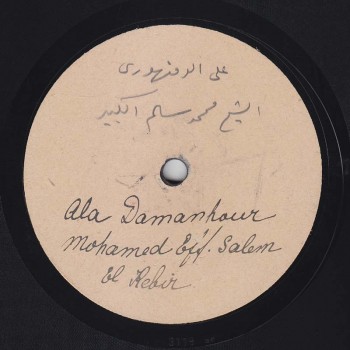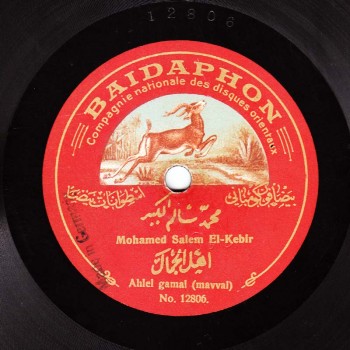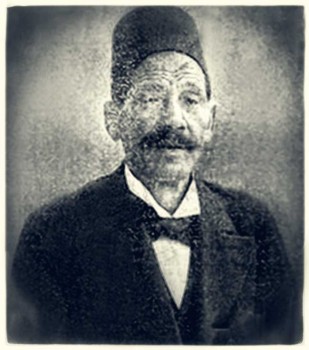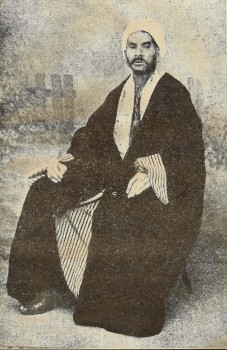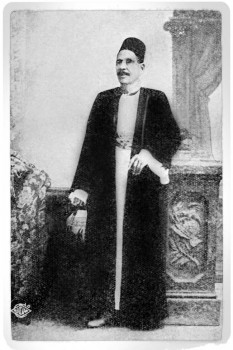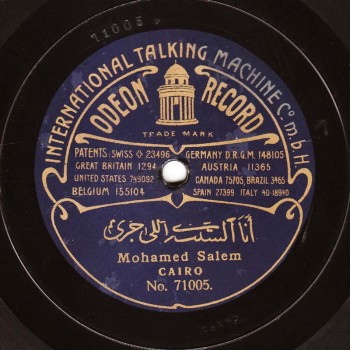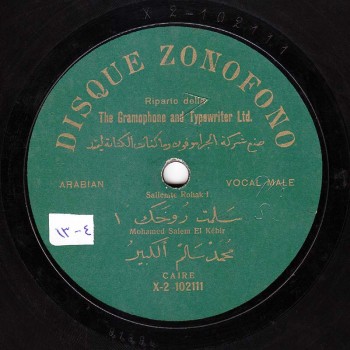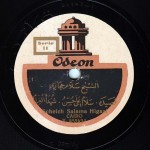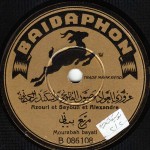Muḥammad Sālim, known as Muḥammad Sālim al-Kabīr (the great), is closest as to the the literary aspect to genius poet Al-Dhubyānī who greatly excelled in poetry while Sālim greatly excelled in singing. And, even though Muḥammad Sālim was more than 15 years ‘Abduh al-Ḥāmūlī’s senior according to some, he only became known as a muṭrib towards the end of ‘Abduh al-Ḥāmūlī’s life. It is said that the latter is the one who presented him as a new muṭrib. He indeed encouraged and helped him reach the first ranks amongst the Nahḍa’s muṭribīn.
Concerning Muḥammad Afandī Sālim’s singing career, it is said that he first worked as a farrāsh (bellboy) –also known as a “nubatgī” or “nabaṭshī”– during concerts. His job consisted in taking care of the band’s seating arrangement as well as in helping to carry and place the equipment..etc. One evening while Muḥammad Sālim was working for Sī ‘Abduh al-Ḥāmūlī’s takht, Sī ‘Abduh arrived early at the concert’s venue during the pre-concert preparations. He found Muḥammad Sālim singing while working and told him “You do not belong here Muḥammad Afandī, your place is among us”. He enrolled him in his takht as a member of the biṭāna, then did with him the same thing he had done with ‘Abd al-Ḥayy Afandī Ḥilmī: he asked him to replace him in concerts and tried to find him a job in singing. He also pushed him towards becoming a known figure in the world of singing.
Let us listen to one of Muḥammad Afandī Sālim’s first recordings. He is singing a dawr “Anā el-sabab fī illī gara” that he had memorized in Sī ‘Abduh’s biṭāna. The recording was made in 1904 by Odeon on one side of a 35cm record –one of the rarest record sizes with a 5 minutes recording capacity’ per side–, order # 71005, matrix # EXX 931. He is accompanied by the Odeon band including Al-Ḥāj Sayyid al-Suwaysī (‘ūd), ‘Abd al-‘Azīz al-Qabbānī (qānūn).
Muḥammad Sālim’s reputation rose towards the end of ‘Abduh al-Ḥāmūlī’s life. He went on singing after the latter’s death but never rose to the stardom of Sheikh Yūsuf al-Manyalāwī and ‘Abd al-Ḥayy Ḥilmī. Yet, Muḥammad Sālim earned the respect of both the listeners and the artistic milieu equally and was nicknamed Muḥammad Sālim al-Kabīr (the great). In his translation of Muḥammad Sālim, Muḥammad Kāmil al-Khula‘ī explains: he was great not only because of his beautiful voice and his masterful singing that reached great heights, but also because of his gentleness, kindness and generosity. The envious nicknamed him Muḥammad Sālim al-‘Agūz (the old one) because of his age. Yet his voice was much more charming and beautiful than theirs, added to the fact that he brought a lot to music. High society members were advised to bring him into their parties and soirées because of his pure voice, his pleasantness as well as his lack of depravity that characterized the other so-called singers.
The distinctive characteristic of Muḥammad Sālim’s recordings resides in the numerous melodic singularities no one but him ever recorded: melodies by unknown composers, most of which following the pre-Ḥāmūlī adwār form, and others resembling the muwashshaḥ. They include a marvellous recording of dawr “Yā ḥlēwā yā msallīnī” attributed to Sheikh Muḥammad ʻAbd al-Raḥīm al-Maslūb, and a recording of the muwashshaḥ-like “Yā dān yā wildān” sang in various manners in the Ḥijāz, especially in the part overlooking the coast of the red sea such as Yunbu‘ and its equivalent in the southeast of Egypt, Qalzam known today as the Suez. These two regions share an almost identical heritage in popular singing, including the instruments and the way the pieces are sang.
Let us listen to one of these strange works: dawr “Yā bū el-‘uyūn el-na‘sāna” to the mu‘allaq, a rāst sub-maqām. Its melody includes unfamiliar elements at the time, and a beautiful and pure leap to a sub-maqām different from the starting sub-maqām. That is the pattern of the mu‘allaq that was very widespread in many popular traditions on the red sea coast, as well as in Yemen, and the Ṣa‘īd.
The recording was made in 1904 by Odeon on one side of a 35cm record, order # 71009, matrix # EXX 935. The accompanying band is the same band that accompanied him in the previous recording.
Such a recording confirms the relationship of Muḥammad Afandī Sālim with singing. Which justifies the words of a Suez orator who said that Muḥammad Sālim went to Cairo at a late age, that he sang for Suez sailors and workers, and that he travelled on numerous occasions on the Kiswah and Ḥajīj palanquin boat. Such information was never mentioned in Music History books. But if it were true, then it would explain why Muḥammad Sālim had memorized so many examples common to Al-Qalzam and the Ḥijāz, examples the citizens of the coast’s two borders call “adwār”. Muḥammad Sālim who was in tune with his century, did not stop at that. After mastering ‘Abduh al-Ḥāmūlī’s and ‘Uthmān’s adwār, he memorized the adwār of the generation that followed them –who were his grandchildren’s age.
We will now listen to an example: dawr “Sallimti rūḥak” sang by Muḥammad Sālim al-Kabīr, written by Sheikh Aḥmad ‘Ashūr and composed by Dāwūd Ḥusnī. It was recorded around 1907 by Gramophone on four 25cm record sides, order # X-2-102111, X-2-102112, X-2-102113, X-2-102114, matrix # 9189 B, 9190 B, 9191 B, 9192 B. Takht Ibrāhīm Sahlūn (kamān) and Muḥammad Ibrāhīm (qānūn).
Muḥammad Sālim’s performance is characterized by its simplicity and its fixed maqām as well as by playing on the rhythm meter of the phrase. Works without a rhythmic cycle illustrate this type of interpretation. The mawwāl is a good example of such works that are based on the rhythm meter of the phrase. In most cases, the mawwāl is a fertile ground for melodic articulations and shiftings. While Muḥammad Sālim greatly exemplifies another type of behavior: playing on the word’s rhythm meter in the melody arrangement.
Let us now listen to mawwāl “Ahl el-gamāl” Muḥammad Sālim al-Kabīr improvised to the sīkāh, and that includes a murāsala and a muḥāsaba with ‘Abd al-Ḥamīd Afandī al-Quḍḍābī (qānūn). It was recorded around 1912 by Baidaphon on one side of a 27cm record, # 12806.
Some sources state that Muḥammad Afandī Sālim al-Kabīr lived until 1927. Yet the information we can affirm is that he made recordings in 1924 with German record company Polyphone.
We will now listen to one of Muḥammad Sālim’s late recordings “ ’Al-damanhūri”.
He recorded it with many record companies. But as we try to offer you the rarest only few were able to listen to, we will play an unpublished experimental recording made on one side of a 27cm record, order # 3119 AR. With Sāmī al-Shawwā (kamān) and ‘Abd al-Ḥamīd Afandī al-Quḍḍābī (qānūn).
We have reached the end of today’s episode of “Min al-Tārīkh”.
We will meet again in a new episode.
- 221 – Zakariyya Ahmed – 12 (1/9/2022)
- 220 – Zakariyya Ahmed – 11 (1/9/2022)
- 219 – Zakariyya Ahmed – 10 (11/25/2021)
- 218 – Zakariyya Ahmed – 9 (10/26/2021)
- 217 – Zakariyya Ahmed – 8 (9/24/2021)
- 216 – Zakariyya Ahmed – 7 (9/4/2021)
- 215 – Zakariyya Ahmed – 6 (8/28/2021)
- 214 – Zakariyya Ahmed – 5 (8/6/2021)
- 213 – Zakariyya Ahmed – 4 (6/26/2021)
- 212 – Zakariyya Ahmed – 3 (5/27/2021)
- 211 – Zakariyya Ahmed – 2 (5/1/2021)
- 210 – Zakariyya Ahmed – 1 (4/28/2021)
- 209 – W-al-Lāhi lā astaṭī‘u ṣaddak 2 (4/6/2017)
- 208 – W-al-Lāhi lā astaṭī‘u ṣaddak 1 (3/30/2017)
- 207 – Bashraf qarah baṭāq 7 (3/23/2017)

